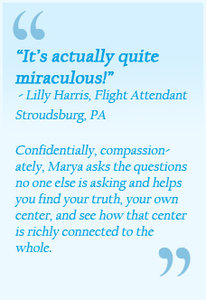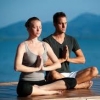The Soul of Touch: How to Heal Ourselves & Heal the World

During the last four months, some very brave souls ventured into an arena where they faced their fears and vulnerabilities to go deeper in discovering of who we are, why we’re here, and where we’re going.
My soul had given me the ridiculously hard job of not only talking about how we define, treat, and enjoy touch in our culture, but had suggested that I offer four seminars on the subject. Soon came a set of lesson plans on Acu-Yoga, Thai Yogassage, and Partner Assists, all of which I’ve studied and used in my work on myself and with clients for more than 20 years. Being one of those daring-trickster creative kinds of people, I found myself integrating touch-point methods I use with private clients in PSYCH-K and Quantum Healing sessions into these seminars.
Exploring healthy touch was, my Higher Self assured me, the best way to create heaven on Earth. By reversing centuries of negative conditioning around touch, we could begin to unlearn harsh, isolating notions that have confused and terrified the human species about one of the most normal of human activities: healthy and playful contact.
So first let me give a shout-out to all the brave and bold individuals who came to these Yogassage seminars. They are daring leaders of a progressive movement that is evolving how we look at touch, how we touch others, and how we feel about being touched. The way these beliefs affect our choices also affects society as a whole. We carry beliefs about touch and everything else in our vehicle for this journey through life: our bodies.
Every winding nerve pathway, cellular memory, and hormonal spurt is shaped in part by what we think and feel. In private energy medicine treatments, we can unwind tension and unleash prana through focusing, belief points, and balances. I wasn’t sure how this body of knowledge would translate into the seminars, but I knew I had to try. My Higher Self makes a request and I respond: “When and where?” I feel tremendously blessed for the students, friends, and colleagues who are taking steps with me to learn about pressure points, acupressure, and ways to recalibrate our understandings of healthy touch, meridians and the energy body.
An epidemic of unhealthy touching rages across our planet. It is evident in brutal abuses of women and children in our homes and workplaces, in wars where civilians and innocents are killed and tossed aside as “collateral damage,” and in the careless treatment of our water, land, and air through pollution for profit. Without doubt, unhealthy learning about touch shapes how many people feel about nature, climate change, social harmony, prosperity, and education. At their roots, these issues stem from how we touch what we love, study, and use, how we touch the Earth, and how we balance the needs of the self with needs of the community.
Exploring healthy touch as an antidote to unhealthy touch seems like a good idea on the surface, doesn’t it? It’s so important that Diane Ackerman famously has said, “Touch seems to be as essential as sunlight.”
So I renewed my knowledge base, interviewed experts, and put together what I knew about healthy touch. I then rolled out the first series of Yogassage seminars in January. They were well- received, but obviously, my Higher Self wasn’t considering the deeply rooted historical context, the Puritanical and Hawaiian taboos regarding touch. Differing ethics regarding touch as well as outright mistrust of touch has created an interesting atmosphere in the blended cultures of West Hawaii. For the more than two hundred years since western “contact” on these easy-going shores, the collision of cultures and unexamined taboos regarding touch have fostered domestic violence, substance abuse, and “touch isolation” in our communities. While low levels of touch have been shown to stall brain development in children and increase risk for disease in adults, it’s still an incredibly “touchy” subject.
To face taboos, especially if they’re religious as well as social, and based on historical custom rather than rational thought, takes courage. The root of the word courage is cor—the Latin word for heart. “In one of its earliest forms, the word courage had a very different definition than it does today,” writes Brene Brown. “Courage originally meant ‘To speak one’s mind by telling all one’s heart.’ Over time, this definition has changed, and, today, courage means to be brave or heroic.
So we’ve come to this. It’s often considered heroic – or creepy — to encourage gentle touch for the purposes of play, healing, and energy therapies, because so many associate touch with romantic intimacy. And because we tend not to want to talk about it until there’s an outrage over violent touch, one of the big problems is that many tend to go directly to the notion that touch is always sexual.
Nothing could be more misleading. Anyone who has experienced healing touch — touching the heart through music, words, and love as well as touching the skin at specific points — knows the feeling of increased energy when more prana, the life force, circulates through all the organic systems. Touch therapies and somatic experiences bring together the body and mind for a reunification of one’s inner power.
But if we believe on some basic level that Touch equals Sex, with so much unexpressed confusion regarding appropriate touch, we stop trusting. Perhaps the two exceptions to this cultural (mis)understanding are, according to Danielle Maxon, “1. Mothers relating with their own children and 2. Professional massage. That’s it. Otherwise, it seems that any touch deeper than a short hug must be sexualized in some way. Touch is an innately human need that we deny ourselves. . . except if you want to shell out $150 to get an hour-long massage! Isn’t that weird and sad?” she asks.
OUR UNHEALTHY, TOUCH-AVERSE CULTURE
With children, our boundaries around touch are extreme, and can impede children almost as much as harmful touch. During a developmental time when kids need more touch, not less, teachers are trained to never hug their students as part of school policy, or if hugs are allowed, to only give “side hugs.”
Parents who read news reports of pedophiles molesting children in churches and schools are genuinely terrified. But how is a well-informed and perfectly innocent teacher supposed to calm down a youngster who is preverbal or Autistic without hugging him?
Be assured if you’re reading this and think, “Oh no, is she talking about me?”
The short answer is no. I’m not calling anyone out personally. But I am acknowledging that we’re all a little confused on the subject. We are an incredibly violent species, as well as a beautifully altruistic one. The difference, according to neuroscientist Robert Sapolsky, is context. “If you get the context right,” he says, “there’s a much better chance of getting everything else right.”
So let’s look at the context of the workplace. Out of the 54 percent of women who say they’ve experienced workplace sexual harassment, only 29 percent reported the issue, while 71 percent did not – usually for fear of being fired. Some surveys indicate that 80 percent of women have experienced sexual harassment in the workplace. The field with the highest levels of reported sexual harassment is food and service hospitality, which in Hawaii is responsible for 14 percent of employment in the state.
Wouldn’t it be easier to teach people how to touch healthfully than to wait until the damaging effects of poor touch dynamics permeate our societies?
REVERSING BEHAVIORAL PROBLEMS IN SCHOOLS
Consider how many behavioral problems in schools could be prevented almost entirely through hugs. You may laugh, thinking what a joke it is to propose that a defiant child, angry student, or depressed teenager could reverse unhealthy patterns by simply being hugged more. But look at our world today.
Seriously, if Donnie Trumpf or Adolf Hitler had been touched lovingly during their developing years, we might have a very different planet.
Of course, starting to even talk about touch can seem scary to people, and no one wants to be seen as scary. People who don’t know the difference between healthy and unhealthy touch may touch inappropriately or they may give up and stop touching at all. Worries over a lawsuit, their intentions being misconstrued, or being perceived as “creepy” keeps many teachers and therapists from doing the right thing.
In my coaching and yoga sessions with clients, where I often use body point balances to help people learn and transform beliefs that are hobbling their desire for a fulfilling life, I always protect myself by having them sign a waiver. Especially with children, I invite another adult to be present or I videotape the session, for my own self-protection.
Parents are understandably concerned about other adults’ intentions, but we’ve taken the issues of touch to such an extreme that the years of confusion, shaming, and judgment have left our modern societies with a bad case of touch deficit disorder. We not only mistrust others, especially men, but we’ve started distrusting ourselves.
Did I enjoy that hug too much? Am I having taboo feelings or unwanted thoughts? Distrust of our own thoughts and sensations makes us feel insecure, uncertain about the extent of Platonic touching allowed unless we have clear rules of engagement. The problem is, with so many even afraid to talk about healthy touch, we often give up and limit our physical contact to children in our own families and significant others in a relationship.
And that’s where we are, putting a huge amount of pressure on one person to provide us with all the loving touch a healthy person needs. Meanwhile, we watch humanity, our planet, and all its creatures suffer from touch deficit.
By way of investigating healthy touch, I searched on Google for listings on the subject of “healthy touch.” A respectable 3,990,000 results about healthy touch came up in .87 seconds, mostly day spas, massage therapy, and eyelash extensions. I entered “unhealthy touch” and 17,700,000 results came up in 0.44 seconds. That’s more than four times more internet information on unhealthy touch than on its opposite, the kind of touch that makes vigorous people and a peaceful society. That higher number doesn’t even include the unhealthy touch in assaults at home and on streets, rape, and how we treat the land, water, and air.
Touch is an innately human need that we too often deny ourselves. By putting the fear of touch first, and by refusing to explore healthy touch in a mindful, loving way, we have thrown out the baby with the bathwater. By avoiding all contact rather than risk even the hint of unwanted sexual touch, by shaming our children for their natural desire for healthy touch, and by not giving them clear indicators of what is acceptable and healthy touch, we have created numerous problems and diminished the many blessings of touch in our lives.
If we could abandon all this avoiding and shaming, I believe we really could rebuild our world. Heaven on Earth might in fact already be at our fingertips. All we have to do is reach out and hug someone!
Here are 15 ways to give and receive more healthy touch:
1 – Hug your children, friends, and family more.
2 – Visit your local massage therapist.
3 – Practice or take a yoga class.
4 – Do Tai Chi.
5 – Dance.
6 – Make time for yourself to sit and touch your heart, remembering self-compassion.
7. Give pats on the back.
8. Take turns “drawing” letters on each other’s backs and guessing the letter.
9. Initiate high fives and fist bumps.
10. Play leap frog.
11. Ask your child, friend, or family member if they prefer a tight squeeze or a gentle squeeze.
12. Make up a secret handshake.
13. Do Body Percussion. Make up routines.
14. Give a foot or hand massage.
15. Touch the happiness you can have when you appreciate more & complain less.
Stay in touch! I would love to hear from you! Let me know if this story has touched you!
Many big blessings,
Marya
P. S. Look for more Yogassage and healthy touch seminars we’ll be offering beginning in September. In the meantime, join us for Gentle Evolutionary Yoga practice on Mondays at 5 pm at the New Thought Center. Learn more here: Monday Yoga with Marya
———————————————————————————————
“At the touch of love everyone becomes a poet.” – Plato
—————————————————————————-


